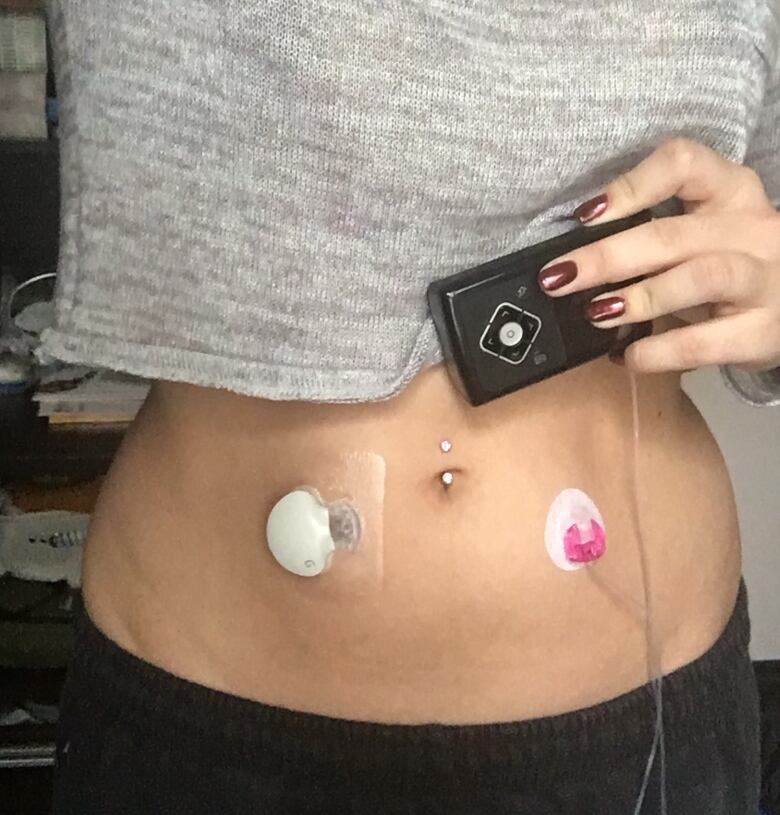Diabetics urge Manitoba government to extend coverage for insulin pumps
Manitoba covers cost of insulin pumps but only up to age 18

A dozen people with Type 1 diabetes are hoping to convince the Manitoba government they need better support, not to be abandoned once they turn 18.
Jessica Williams will be among a group meeting with some MLAs at the legislative building to lobby them to improve coverage for insulin pumps.
"I would love to get across to them just how demanding this disease is — not even just cost, but physically, emotionally, everything. It takes 100 per cent of you," said the 23-year-old, whose pump is connected to her body and automatically delivers a small and continuous amount of insulin to maintain her blood sugar.
"If it's not in the forefront of your mind and you forget [to manage it], you're going to have consequences later, so having an insulin pump makes so much of a difference in the quality of our life and on the health-care system."
If diabetes isn't controlled properly it can lead to kidney failure, amputations, blindness, heart disease and liver disease. That control must be done through needle injections of insulin or through a pump like that used by Williams.

Using needles requires multiple daily injections that can be impractical at work or school. Needles can also be forgotten or lost and leave diabetics more susceptible to sudden highs and lows in blood glucose levels.
Pumps are more reliable but expensive; one will last four or five years but costs around $7,000, plus another $500 a month in supplies — catheter, needle, reservoir and insulin.
In 2012, the then-NDP government brought in a program to cover the cost of pumps, but only for people under 18.
A number of other provinces cover the cost up to age 25, while some provinces and territories cover it regardless of the patient's age.
"Diabetes is a lifetime disease. It doesn't just go poof when you are 18, so the funding for something as important as the insulin pump shouldn't go poof," Williams said.
She was diagnosed two weeks before her 10th birthday after her health started to decline. She started to lose weight, had an unquenchable thirst, and couldn't make it through a class at school without having to leave to use the washroom.
Since then, Williams has learned how to live well with the disease and credits that to the pump, which she has used for 12 years.
Pumps provide freedom, normalcy
Pumps not only help a diabetic physically, but also psychologically, by making them feel normal, she said.
"I didn't have to pull out a needle every time I wanted to have a little snack," she said, noting she could enjoy a party day in elementary school without feeling embarrassed.
"If somebody brought in cookies, I could eat them."

She can also be less rigid about her plans for the day because the pump enables her to adjust her insulin on the fly if she decides to do some sports or other activities that demand more of the body's sugars.
Even going to a restaurant can be a challenge for someone managing diabetes with needles, she said.
"It's always easier to eat processed [foods] when you have diabetes, even though it's way more unhealthy, because it has the carbohydrates printed right on [the label]," she said. "If you're going out to a restaurant or doing home cooking, it's harder to guess, and lots of times your guessing is wrong and then you have to compensate for that."
When she was younger, there was no provincial coverage for her pump but her dad's work insurance plan paid for it.
Recently, Williams panicked when her pump broke down — the first time she needed a new one since aging out of provincial coverage.
She wasn't working at the time, no longer living as a dependent at her parents' house, and wondered how "to find $7,000 out of thin air."
Williams started crying when she learned her boyfriend's insurance would cover it. But there are many others who aren't as lucky, who don't have coverage and don't have the income to afford a pump, she said.
"When I turned 18, I didn't lose this disease. In fact, it got harder for me [to afford a pump] because I was moving out, I was starting university and you're losing that support that you have at home," Williams said.
"And now the government is saying, 'Oh, because you're 18, we don't support you, either."
"We recognize the seriousness of diabetes and continue to provide benefit coverage through Pharmacare for most diabetic medications, insulin, syringes, needles, blood glucose test strips, lancets and infusion sets used with insulin pumps," a provincial spokesperson said.
"There is no published research data that provides strong scientific support for use of insulin pumps to improve patient outcomes. Reports indicate that more long-term data is required," the spokesperson said, adding the province "will continue to review the issue of insulin pumps for adults."